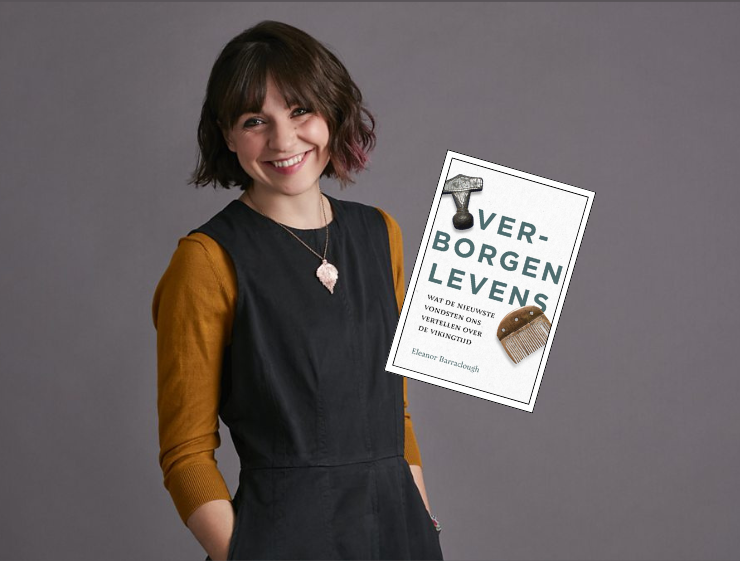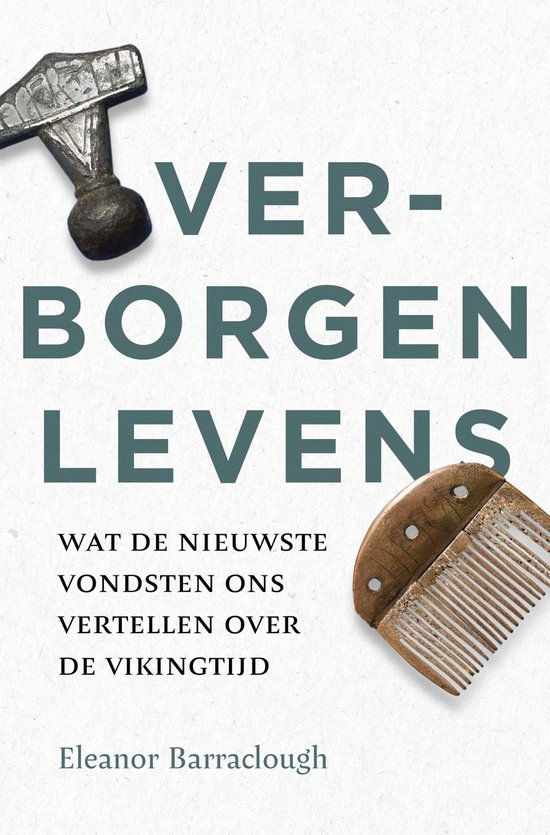DE VERGETENEN UIT DE VIKINGTIJD
- Maartje Kramer

- 20 jul
- 6 minuten om te lezen
Bijgewerkt op: 12 aug

Het nieuwe boek Verborgen levens: Wat de nieuwste vondsten ons vertellen over de Vikingtijd (originele titel: Embers of the Hands: Hidden Histories of the Viking Age),van historicus Eleanor Barraclough verdiept zich niet in de heldhaftige verhalen over sterke, stoere Vikingmannen, maar in de werelden van hen die vaak vergeten worden. Vrouwen, kinderen, tot slaaf gemaakten, reizigers, handelaren en zelfs zieners. Mensen die geen zwaarden droegen of mythische zeeslagen wonnen, maar wiens leven óók de Vikingtijd vormgaf. Barraclough neemt je aan de hand van archeologische vondsten mee naar de randen van het verhaal. Of beter gezegd: naar het hart van de samenleving.
Als ik een fantasy boek opensla, ben ik al gelukkig als er een kaart voorin staat. Het geeft overzicht, houvast, verbeelding. Bij dit boek voelde ik datzelfde genoegen, ook al is het non-fictie. De kaart van Europa voorin toont duidelijk welke plekken Barraclough gaat bespreken. Niet alleen geografisch, maar ook wat betreft narratief biedt de Engelse historicus structuur. Ze maakt ruim gebruik van bronnen en is transparant over hoe ze deze interpreteert: waar ze stevig op kan bouwen en waar ruimte blijft voor twijfel, gissing of reconstructie.
Het boek heeft een academische inslag, maar leest verrassend soepel. Soms zelfs poëtisch. 'Een heldere vlam van het leven flikkert meestal kortstondig op, gloeit, en verdwijnt dan weer in het duister,' schrijft Barraclough wanneer ze reflecteert op hoe weinig we vaak weten over de mensen in haar boek. Door hun sintels opnieuw aan te blazen, wekt ze hen tijdelijk tot leven. Niet als sprookjesfiguren maar als tastbare mensen met dromen, angsten, taken en taal.
In elk hoofdstuk staat een specifieke archeologische vondst centraal. Van grafgiften, speelgoed, dagelijkse objecten tot runeninscripties. Telkens vormt zo’n object het startpunt voor een bredere verkenning van de leefwereld van mensen in de Vikingtijd. Voor elk hoofdstuk bouwt Barraclough eerst zorgvuldig de context op waarin deze vondst begrepen moet worden. Pas daarna duikt ze in de details van het object zelf en vertelt ons wat dat betekent. Die opbouw is prettig. Barraclough nodigt de lezer uit tot meebewegen en zorgt voor de historische context waarin deze levens zich ontvouwen. Hierin zie je de academicus, maar ook de verhalenverteller. Hoewel de thematiek vaak heftig is: kolonisatie, grof geweld en verlies, blijft de tekst toegankelijk en gelaagd.
Barraclough laat bijvoorbeeld zien hoe runen niet alleen religieus of ritueel gebruikt werden, maar ook voor alledaagse communicatie. Aan de hand van gekerfde boodschappen en grafvondsten leren we dat ook vrouwen bekend waren met schrift. Ze schreven hun naam, noteerden raadselachtige spreuken of stuurden zelfs berichten. Zulke details maken hun levens tastbaar. Het zijn geen anonieme vrouwen meer, maar mensen met handschrift en een stem.
Een ander hoofdstuk richt zich op een begrafenisvondst waarin zowel lokale als buitenlandse objecten zijn gevonden. Het roept vragen op over migratie, culturele uitwisseling en identiteit. Barraclough maakt duidelijk dat de Vikingtijd veel minder geïsoleerd en eenduidig was dan we vaak denken. De wereld was verbonden over zee en over land, via handel, roof, huwelijk en slavernij.
Wat dit boek bijzonder maakt, is dat Barraclough geen definitieve geschiedenis wil voorschrijven. Ze opent ramen. Soms klein, soms groot, maar altijd met oog voor nuance. De feiten zijn stevig onderbouwd, maar er is ook ruimte voor verbeelding. Hoe was het om als kind een lange winter te doorstaan zonder haard? Of als tot slaaf gemaakte vrouw mee te reizen naar het onbekende? Hoeveel sporen laat een leven achter en wie bepaalt wat bewaard blijft?
Verborgen Levens is geen boek dat je in één ruk uitleest. Het nodigt uit tot pauzeren, herlezen en overdenken. Het is een historische reconstructie, maar ook een oefening. Zijn we bereid echt te kijken naar wie eeuwenlang niet gezien zijn? Wat doen we met hun verhalen, nu we ze stukje bij beetje terugvinden in de aarde? Voor wie geïnteresseerd is in de menselijke kant van de Vikingtijd en niet de mythische helden, maar de werkelijke levens is dit boek een aanrader. Eleanor Barraclough werpt nieuw licht op oude as en laat zien hoe zelfs de zachtste gloed iets wezenlijks kan onthullen.

Verborgen levens: wat de nieuwste vondsten ons vertellen over de Vikingtijd van Eleanor Barraclough (9789401920971 paperback €29,99) is nu verkrijgbaar in de boekwinkel of direct te bestellen bij uitgeverij Omniboek.

Maartje Kramer is een gedreven archivaris en erfgoedprofessional met een passie voor het uitpluizen van geschiedenis. Ze heeft een achtergrond in Cultureel Erfgoed, gestudeerd aan de Reinwardt Academie. Maartje deelt graag haar kennis, het liefst met een insteek over historische kleding en recepten. Naast haar werk is ze een enthousiaste keukenprinses, (dakterras) moestuinhoudster en heks.
- ENGLISH BELOW -

Embers of the Hands: Hidden Histories of the Viking Age by historian Eleanor Barraclough doesn’t focus on the well-worn tales of strong, stoic Viking men. Instead, it turns its attention to those whose lives have often been left in the shadows of history: women, children, enslaved people, travelers, traders, and seers. Through archaeological discoveries, Barraclough draws these lives out from the margins and into the heart of the Viking Age.
Personally, I’m always delighted when a book (especially in the fantasy genre) opens with a map. It offers direction and invites the imagination. Despite being nonfiction, this book gave me that same feeling. A map of Europe provides a clear overview of the sites explored throughout the chapters. Barraclough not only orientates us geographically, but also narratively. She carefully explains how historical sources were used in her research, what conclusions can be drawn from them, and where interpretation or reconstruction comes into play. The book’s academic foundation is solid, but the writing remains fluid and inviting.
Some passages even read like poetry. “A bright flame of life usually flares up briefly, glows, and then disappears into the darkness,” she writes, reflecting on the fleeting nature of historical presence. The image of rekindling embers becomes a guiding metaphor. With each chapter, Barraclough breathes life into stories nearly lost to time. These are not legends or archetypes, but people with voices, tasks, fears, and identities.
Each chapter centers around an archaeological discovery. From grave gifts, toys, daily items to rune inscriptions. These finds are explored not just for their physical details, but for the lives and cultural worlds they evoke. Before diving into each artifact or site, Barraclough first paints the context in which that life unfolded. She asks us to understand the world before we try to understand the story. This approach balances scholarly depth with readability and invites the reader to slow down and truly observe.
One of the striking insights of the book is the presence of literacy among women. Runic inscriptions show us that some women knew how to read and write, leaving behind carved messages, names or cryptic phrases. These markings offer rare glimpses into personal agency and memory. They remind us that stories don’t always come from grand monuments. Sometimes they’re scratched into the side of a comb or a piece of wood. Elsewhere, we encounter burials that include objects from distant lands. These findings challenge the idea of a closed Viking world. They point instead to mobility, trade, forced migration, and contact across cultures. Barraclough consistently shows that the Viking Age was more interconnected and diverse than we might expect.
What makes this book compelling is that it doesn't try to tell a single, linear history. It offers a mosaic of perspectives. Some discoveries raise more questions than answers. Others speak loudly through their silence. The book trusts the reader to sit with uncertainty and to appreciate how historical truth is often layered, complex, and partial.
Embers of the Hands is not a fast read. It rewards reflection and invites re-reading. It is both a work of historical recovery and a quiet act of recognition. Are we willing to look directly at the people history has neglected? And now that we are finding their traces, how will we carry their stories forward? For those drawn to the human side of the Viking Age. Beyond the myths, beyond the warriors, this book offers a rich, moving, and beautifully researched journey. Barraclough shows us that even the faintest ember can warm us with its light, if only we take the time to see it.

Embers of the Hands: Hidden Histories of the Viking Age by Eleanor Barraclough (9789401920971 hardcover €39,99) is now available in bookstores or via the webshop of The American Book Centre

Maartje Kramer is a passionate archivist and heritage professional with a passion for teasing out history. She has a background in Cultural Heritage, studied at the Reinwardt Academy. Maartje enjoys sharing her knowledge, preferably with an insert on historical clothing and recipes. Besides her work, she is an enthusiastic kitchen princess, (rooftop) vegetable gardener and witch.






Opmerkingen